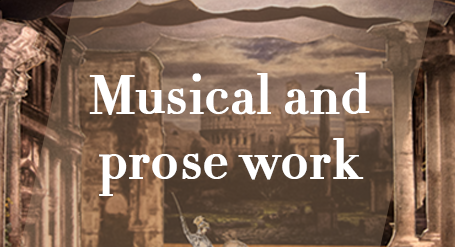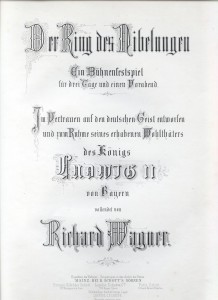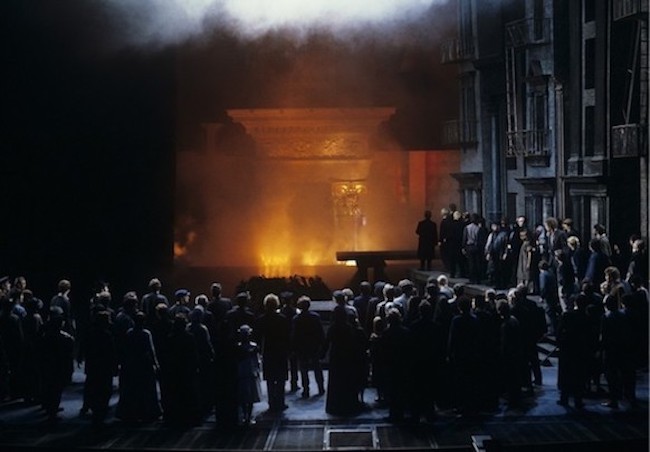
The musical work of Richard Wagner is composed of operas or “musical dramas” ranging from “Fairies” (Die Feen) to “Parsifal”. A detailed presentation of each of these major works is associated here with a set of thematic articles, placing them not only in the context of his personal life but also in his social, economic and cultural context. This section also includes all the musical works (excluding opera) and his literary work.
The Ring of the Nibelung, WWV86
Der Ring des Nibelungen, WWV86
Cycle of four German-language epic music dramas.
The four parts that constitute the Ring cycle are, in sequence:
- Das Rheingold (The Rhinegold)
- Die Walküre (The Valkyrie)
- Siegfried
- Götterdämmerung (Twilight of the Gods)
Text and music by Richard Wagner
Premiere of the full cycle:
The first performance as a cycle opened the first Bayreuth Festival in 1876, beginning with Das Rheingold on 13 August and ending with Götterdämmerungon 17 August, conducted by Hans Richter.
The Rhinegold (Das Rheingold) had been performed against Richard Wagner’s will (but pressed for an early performance by King Ludwig II of Bavaria) and produced at the Munich Hofoper on 22. september 1869.
So had been The Valkyrie (Die Walküre) which was performed, as a single opera, at the National Theatre Munich on 26 June 1870.
Cast:
The Gods
WOTAN, God of battle, and of contracts, ruler of the gods (bass-baritone)
LOGE, Demi-god of fire, Wotan’s clever, manipulative executive servant (tenor)
FRICKA, Goddess of family values; wife to Wotan (mezzo-soprano)
FREIA, Goddess of love and beauty, guardian of the golden apples (soprano)
FROH, God of spring and sunshine; Freia’s gentle brother (tenor)
DONNER, God of thunder; Freia’s hot-tempered brother (baritone)
ERDA, Primal earth mother, goddess of earthly wisdom (contralto)
The Wälsungs
SIEGMUND, mortal son of Wotan (tenor)
SIEGLINDE, his twin sister (soprano)
SIEGFRIED, their son (tenor)
The Valkyries
BRÜNNHILDE (soprano)
WALTRAUTE (mezzo-soprano)
HELMWIGE (soprano)
GERHILDE (soprano)
SIEGRUNE (mezzo-soprano)
SCHWERTLEITE (contralto)
ORTLINDE (soprano)
GRIMGERDE (contralto)
ROSSWEISSE (mezzo-soprano)
The Nibelungs
ALBERICH, Power-hungry dwarf, lord of the Nibelungs (baritone)
MIME, Alberich’s brother, a cowardly expert metal-smith and Siegfried’s foster father (tenor)
The Giants
FASOLT, Giant, in love with Freia (bass)
FAFNER, Giant; Fasolt’s ruthless brother (bass)
The Neidings
HUNDING, Sieglinde’s husband, chief of the Neidings (bass)
The Gibichungs
GUNTHER, King of the Gibichungs (baritone)
GUTRUNE, his sister (soprano)
HAGEN, their half-brother, and Alberich’s son (bass)
The Rhinemaidens
WOGLINDE (soprano)
WELLGUNDE (soprano)
FLOSSHILDE (mezzo-soprano)
The three Norns (the weavers of fate, daughters of Erda)
First Norn (contralto
Second Norn (mezzo-soprano)
Third Norn (soprano)
The Voice of a Woodbird (soprano)
A male choir of Gibichung vassals and a small female choir of Gibichung women (chorus)
![]()
The Ring of the Nibelung (Der Ring des Nibelungen) is a cycle of four operas with, successively, The Rhinegold (Das Rheingold, WWV86a), The Valkyrie (Die Walküre, WWV86b), Siegfried (WWV86c) and Twilight of the Gods (Götterdämmerung, WWV86d) created by Richard Wagner.
 Composed over nearly 30 years of the composer’s life – that is between 1848 and 1876 – this gigantic work was intended to be performed on the stage of the Bayreuth Festival Theatre, built according to the composer’s wishes in optimal execution and staging conditions. Interrupted multiple times during both the writing of his libretto and the music composition, redesigned as many times, Wagner’s titanic work (nearly sixteen hours of music in total) took to its pinnacle the concept of Gesamtkunstwerk (Total work of Art) that the revolutionnary artist presented and defended throughout his career as a composer and playwright, especially in his essays (Opera and Drama and The Artwork of the Future).
Composed over nearly 30 years of the composer’s life – that is between 1848 and 1876 – this gigantic work was intended to be performed on the stage of the Bayreuth Festival Theatre, built according to the composer’s wishes in optimal execution and staging conditions. Interrupted multiple times during both the writing of his libretto and the music composition, redesigned as many times, Wagner’s titanic work (nearly sixteen hours of music in total) took to its pinnacle the concept of Gesamtkunstwerk (Total work of Art) that the revolutionnary artist presented and defended throughout his career as a composer and playwright, especially in his essays (Opera and Drama and The Artwork of the Future).
The musical world had lost, since the Baroque period, the habit of drawing inspiration from the mythological resources (the Greek and Roman ones generally) in favour of historical contexts conducive to the development on stage of the splendour of the great romantic opera with strong choruses, marches, parades and more or less truthful evocations of characters who actually existed.
But in order to give a symbolic and timeless dimension to what he considered, since its draft, as his “Great Work“, Richard Wagner, then exiled to Zurich after being banished from the Germanic Confederation, composed the poetic text in verse of his titanic project using characters emanating from the Legend of the Nibelungen. (read more…)
If you wish to share further information about this article, please feel free to contact us !
